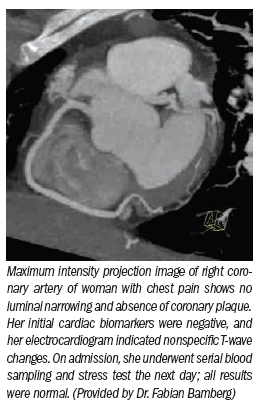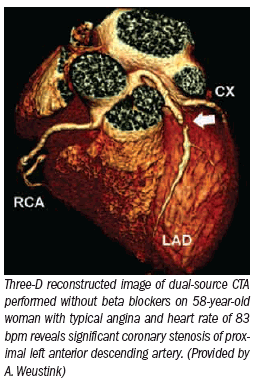Multislice CT closes inon emergency triage role
Cardiac imaging researchers are validatingbroader clinical roles for 64-slice and dual-source CT while introducingthe radiological world to evenmore powerful machines that promiseto lower radiation exposure andimprove resolution.
Cardiac imaging researchers are validating broader clinical roles for 64- slice and dual-source CT while introducing the radiological world to even more powerful machines that promise to lower radiation exposure and improve resolution.
The Rule-out Myocardial Infarction Using Computer-Assisted Tomography (ROMICAT) trial moved multislice CT angiography closer to acceptance as an emergency room triage tool to identify chest pain patients at low or intermediate risk of acute coronary syndrome who can be discharged without additional tests and hospitalization.
Based on 368 consecutive patients, the three-year trial at Massachusetts General Hospital is the largest study so far to examine the value of 64-slice cardiac CTA in the ER, said Dr. Udo Hoffmann, director of the cardiovascular imaging program at MGH. The study found that nearly half of patients presenting with chest pain but who are at low or intermediate risk of acute coronary syndrome can be safely discharged following a negative 64-slice coronary CT evaluation.

The ability of 64-slice CTA to allow two of every five low- to intermediate- risk patients with chest pain to go home without further evaluation will soon lead MGH to adopt the exam as a standard part of its ER routine, Hoffman said. It will be one of four hospitals to participate in ROMICAT II. Starting in March 2009, 1000 patients will be recruited to secure a more definitive answer about CTA and ER triage.
Other studies suggested that coronary CTA can identify which intermediate- risk patients are most likely to suffer future catastrophic coronary events. In a cohort study involving 452 patients. Dr. Joseph Abro of the University of South Carolina established a 100% negative predictive value for the likelihood of a future major cardiac event for 198 patients whose coronary CTA evaluations were negative for significant coronary occlusion. About 30% of the 87 patients with coronary CTA findings that were positive for a greater than 50% stenosis experienced a major event within a year.
The study population proved too small, however, to also determine whether plaque composition or Agatston coronary calcium scores could predict cardiac risk, according to supervising researcher Dr. Uwe Joseph Schoepf. But he is convinced that larger studies will eventually establish that noncalcified plaque burden measured with coronary CTA can play that role.
A cohort study involving 373 symptomatic patients at Erasmus Medical Center in Rotterdam, the Netherlands, validated that the dualsource Somatom Definition CT scanner (Siemens) can produce high-quality coronary artery studies without beta blockers to slow heart rate.
The exam characterized 671 lesions involving 50% or greater stenosis. The per-segment sensitivity specificity of 95% and 94%, respectively, of the scanner for patients with heart rates at or above 80 beats per minute were nearly identical to accuracy rates for patients with heart rates below 65 bpm, said chief investigator Dr. Annick Weustink.

Emphasis on radiation dose reduction at the 2008 RSNA was evident in studies describing the initial experience with 256-slice and 320-slice platforms.
Historically, these introductory papers concentrate on increased image quality with a few readers judging the studies on a qualitative scale.
Dr. Narinder Paul of Toronto General Hospital, however, gave equal billing to the radiation reduction from the 320-slice Aquilion One (Toshiba America Medical Systems) in a comparison with a 64-slice scanner.
Based on experience with 25 healthy volunteers examined on each scanner, no clinical differences were observed, but pulsed radiation with the 320- slice system using windows of 35% to 75% and 70% to 80% achieved radiation dose reductions of 60% and 76%, respectively, compared with the 64- slice configuration.
What New Lung MRI Research Reveals About Post-COVID-19 Conditions in Children and Adolescents
February 25th 2025Adolescents with post-COVID-19 conditions had 37 percent lower quantified lung perfusion than healthy control participants on phase-resolved functional lung MRI, according to findings from a recent prospective study.